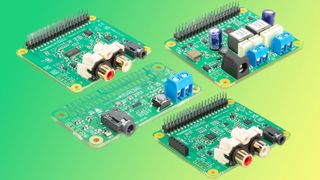Raspberry Pi Turns Its IQAudio HATs Green
IQAudio boards absorbed into Big Raspberry

Raspberry Pi has revamped many of its audio add-ons, replacing the previously black PCBs of the HATs with green ones to match the SBCs they’re paired with. There are a few minor layout and connector alterations too, but otherwise, the boards remain functionally unchanged. In a blog post, Raspberry Pi-maker Eben Upton explained what’s going on.
The audio HATs sit on top of a Raspberry Pi board with GPIO, such as the Raspberry Pi 4, connecting to its GPIO pins and adding high-quality amplifiers, DACs, and phono outputs. IQaudio was founded in 2015 to create better quality sound products for Raspberry Pi boards used for things like streaming audio in stores and other businesses. However, it was absorbed into Raspberry Pi in 2020.
While the Raspberry Pi 4 can output sound via Bluetooth, its HDMI outputs, and a 3.5mm headphone jack, the audio HATs improve on this. The smallest is the Codec Zero, which features a 24-bit 96kHz Dialog Semiconductor DA7212 DAC, a built-in microphone and external microphone input socket, a mono speaker terminal, and stereo input and output channels. It's useful for projects like walkie-talkies and smart doorbells. Or for the amusing chatterbox the Raspberry Pi team built in the video above.
The DigiAMP+ holds a Texas Instruments TAS5756M stereo amplifier and stereo speaker outputs. It requires its own external power source but will also supply power to your Pi board. If you want to turn your Pi into a hi-fi system, this is the one to choose. There's also a pair of DAC boards: the DAC+ and the DAC Pro. They both have headphone amplifiers and sockets, but the DAC Pro adds a balanced/differential output in parallel to the line out.
The new boards are made in the UK but are available worldwide from approved resellers. Any layout changes aim to make the boards simpler and quicker to manufacture, and the only significant difference is that the PCBs are now green. Raspberry Pi has a specifications comparison document to help you choose which audio board best suits your needs.
Stay On the Cutting Edge: Get the Tom's Hardware Newsletter
Get Tom's Hardware's best news and in-depth reviews, straight to your inbox.

Ian Evenden is a UK-based news writer for Tom’s Hardware US. He’ll write about anything, but stories about Raspberry Pi and DIY robots seem to find their way to him.
Most Popular





